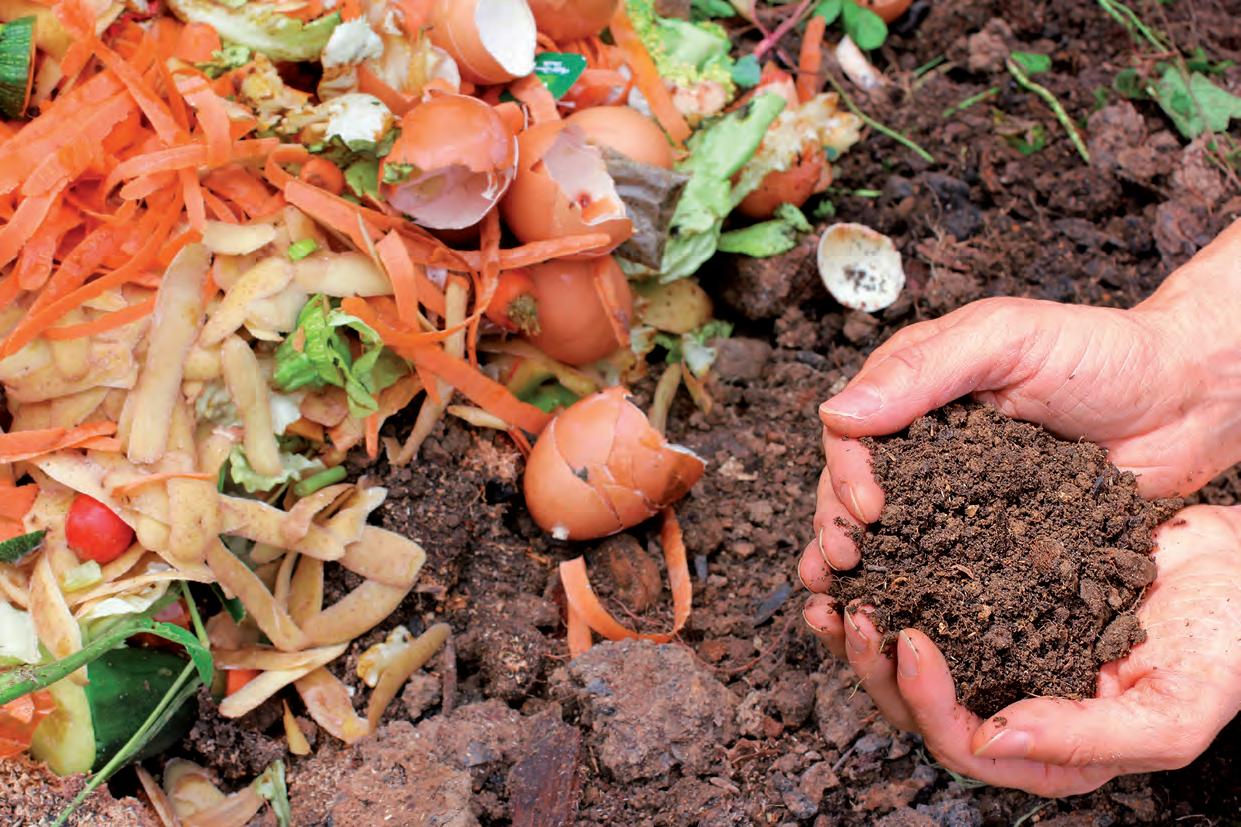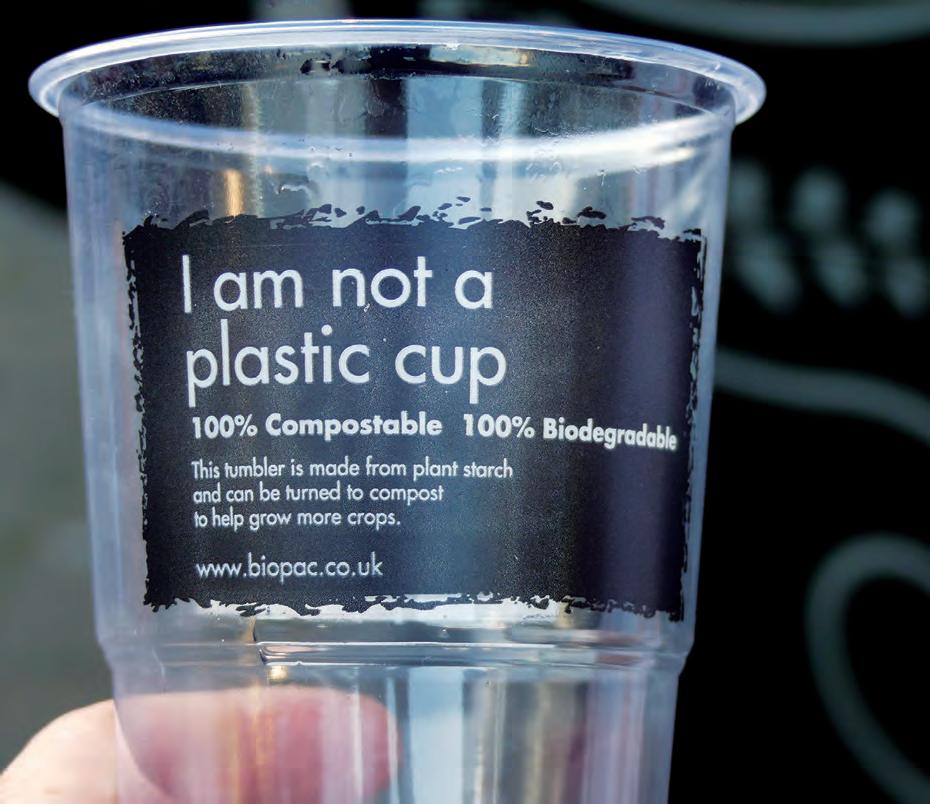
8 minute read
AIP
Consumers are sometimes confused about the difference between what is biodegradable and compostable.
Defining compostable and biodegradable packaging
AIP president, Dr Carol Kilcullen-Lawrence, gives the run down on the difference between biodegradable and compostable packaging.
Packaging is under the spotlight, and rightly so as we progress towards achieving Australian National Packaging Targets, whereby all packaging, by 2025 should be recyclable, reusable or compostable.
So let’s have a closer look at what is meant by compostable, why it is so often confused with biodegradable and, in a packaging context, what does the consumer do with the empty package?
For compostable packaging to be utilised to its full potential, what needs to change in our waste collection steams? Now that renewable packaging is starting to gain momentum, what does bio-based add to the supply chain and why are bio-based raw materials not necessarily biodegradable?
What is compostable? Although not many consumers have access to one, we are familiar with compost heaps. The composting process allows us to dispose of leftover foods for example to decompose and creates fertiliser for your soil. When it comes to compostable packaging however, we need to understand that backyard composts have a completely different set of physical conditions than industrial composting facilities – an important distinction. Industrial composting can cope with a wider range of compostable products as it involves pre-processing – where materials are ground and chipped down into smaller pieces, and in addition, industrial composting provides the higher temperatures needed for more efficient break down. Home composting takes place at much lower temperatures and over an extended time frame, which can typically go up to a year, compared to a matter of weeks for industrial composting.
Compostable packaging will likely not break down in a landfill, as they lack the right conditions, especially in a modern landfill where there will be no oxygen. The only desirable waste stream for compostable packaging is an industrial compost facility. And while not currently available in all regions of Australia, industrial
composting facilities are becoming increasingly widespread with many more councils and private companies providing bins, where food scraps and garden waste can be disposed of together. However, with a significant amount of education required to advise consumers about what can go into such bins, many council schemes do not permit packaging of any type, in case it results in a negative impact due to the wrong packaging ending up at an industrial composting facility. As the volumes of compostable packaging on the market are relatively small, the impetus to study its compatibility with council schemes is low.
What is Biodegradable? Everything will degrade over time, but true biodegradation occurs through a biochemical process, with the aid of enzymes produced by naturally occurring microorganisms, both in the presence and absence of oxygen i.e. aerobic or anaerobic, without leaving behind any toxins, yielding only carbon dioxide, water and humus or biomass. Biodegradation is just a natural process taking its course and breaking down materials to their component parts.
Biodegradable packaging can be derived from several sources, including renewable sources – like paper or bioplastics, as well as petroleum-based plastics, which are specifically engineered, to decompose in the natural environment, which is significant at the end of life. A biodegradable plastic will be considered a contaminant in the plastics recycling stream, as on being exposed to moisture and appropriate microorganisms, the biodegradation process will commence.
So, we are clear on what is compostable and what is biodegradable, subtle but important differences when it comes to disposing of the package in the right waste stream. Now let’s not allow ‘bio-based’ to add any confusion. A package derived from a ‘bio’ source, can be designed to be compostable or biodegradable, however it is equally possible that it is not – meaning the package can be disposed of with likepackaging in a recycling stream for example.
Many different renewable ‘bio-based’ ingredients are now used as packaging inputs. Some enable compostable and biodegradable packages, whereas others produce packaging that is identical to that from fossil-based sources hence, the bio-based packaging can be recycled with like polymers. Examples are bio-polyethylene and polypropylene derived from plant based renewable feed stocks, that have properties that cannot be distinguished by the equivalent polymers derived from petrochemicals. The following summarises the two sources of plastic – fossil based and renewable, with their corresponding four attributes:
All these packaging formats are desirable – as long as the consumer has the right information and the right facilities for proper disposal. Currently whilst there are standards and guidelines from organisations such as the Australian Industrial Composting Standard (AS4736) and the Australian Organics Recycling Association, there is no universally recognised symbol for labelling consumer packaging. With the uptake of the Australasian Recycling Label (ARL), this problem could be addressed down the track. Compostable and biodegradable packaging comes into its own where it enables food waste to be captured in the organics waste sector and this is predominantly at public events where the inputs to the waste stream can be controlled. This is likely to be the area in which we see the most growth in compostable and biodegradable packaging and provided that growth mirrors the capacity of the organics collections to handle it, that’s a positive outcome on all fronts. F
Fossil-based
Bio-based
Biodegradable
Some fossil-based plastics, whilst not common in packaging, are biodegradable. Examples are polybutyrate adipate terephthalate (PBAT) and Polycaprolactone (PCL)
Polylactic Acid (PLA) is an example of a Bioplastic which made from renewable sources. It is also biodegradable.
Non-biodegradable
Conventional Plastics like HDPE, PP and PET are derived from fossil sources and whilst not biodegradable, they are recyclable.
Plastics like PE, PP and PET can also be derived from renewable sources and hence are known as Bioplastics. This does not mean that they are biodegradable. However, they are recyclable with conventional plastics.

Light curtain saves time and safeguard worker wellbeing
Allen Bradley GuardShield light curtains have a couple of cutting-edge features that help with worker safety. Food & Beverage Industry News explains.
Light curtains can be the last line of defence in a food and beverage manufacturing plant, especially in operations that require cutting, chopping and packaging of produce.
Jack Wheatley is the product manager for safety, sensing and signalling for NHP, an electrical engineering company that specialise in electrical and automation products, system and solutions. NHP offer unique products such as Allen Bradley GuardShield light curtains that help to improve the safety in food and beverage manufacturing plants. He knows how they can be used best within factories that produce food and beverages.
The Allen Bradley GuardShield range of light curtains has a few special features that are designed to make them not only cost-effective, but also reduce the investment required in maintaining spare parts.
Typically, a light curtain is used on machinery or production lines where regular access is required. Operators don’t want to be restricted by having to constantly open and close guards. They want to have access to the area, whether it is during production or during a downtime.
Being a transceiver and receiver, many light curtain installations require two separate light curtain sticks. The Allen Bradley GuardShield curtain leverages patented plug in transceiver technology where each stick can be used as a transmitter or receiver via the innovative plug-in modules.
“The concept of this design is to minimise on parts required,” said Wheatley.
“This new design reduces the number of parts required and will allow customers to better maintain production facilities with fewer

spare parts. Additionally, for a supplier to keep stock, it’s about having the ability to hold a single length curtain, plug in module, and better service the market.
“Additionally, the patented plug design has embedded functions which are configured quickly and easily via DIP switches or software, significantly reducing engineering effort. These include: muting, blanking, start mode, external device monitoring (EDM) and scanning ranges” said Wheatley.
Another feature that Wheatley has highlighted is the laser alignment capabilities, which give the user an enhanced Integrated Laser Alignment System (ILAS) for quick installation and reliable operation.
“This cuts installation alignment labour time significantly, which is a significant benefit across multiple installs,” said Wheatley. “Prior to having this embedded technology, it was a tedious task for customers”.
Wheatley said that the most exciting feature is the Allen Bradley GuardShield being the first safety light curtains on the market to be Ethernet-enabled.
“With the release of the 450L-ENETR Ethernet adapter, detailed diagnostics and status information will be conveniently available to customers when integrating into a networked PLC
The GuardShield light curtain minimises the number of parts required to set it up.
system,” said Wheatley.
“At NHP, we understand that all equipment as part of a food or beverages manufacturing process is critical to its operation and maintenance crews require reliable components along with product support. This is one of NHP’s key values when going to market,” said Wheatley.
“NHP has a product technical phone service that all customers can access for engineering support,” he said. Further to that, Rockwell Automation, who manufacture the product, also have a paid service technical support hotline.
The units come in different lengths ranging from 150mm up to 1950mm – in multiples of 150mm in both 30mm and 14mm resolutions. There are no dead spots (passive zones) at the top or bottom of the stick, which means they can be installed inside a machine frame and do not have be mounted outside/ on the machine like a traditional light curtain system. F










